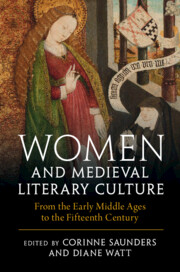Book contents
- Women and Medieval Literary Culture
- Women and Medieval Literary Culture
- Copyright page
- Contents
- Illustrations
- Contributors
- Acknowledgements
- Introduction
- I Patrons, Owners, Writers, and Readers in England and Europe
- II Circles and Communities in England
- III Health, Conduct, and Knowledge
- IV Genre and Gender
- Chapter 11 Lyrics
- Chapter 12 ‘It satte me wel bet ay in a cave / To bidde and rede on holy seyntes lyves’
- Chapter 13 Tears, Mediation, and Literary Entanglement
- Chapter 14 Convent and City
- Chapter 15 Women and Romance
- Chapter 16 Trouble and Strife in the Old French Fabliaux
- Chapter 17 Chaucer and Gower
- V Women as Authors
- General Index
- Index of Manuscripts
- References
Chapter 12 - ‘It satte me wel bet ay in a cave / To bidde and rede on holy seyntes lyves’
Women and Hagiography
from IV - Genre and Gender
Published online by Cambridge University Press: 28 July 2023
- Women and Medieval Literary Culture
- Women and Medieval Literary Culture
- Copyright page
- Contents
- Illustrations
- Contributors
- Acknowledgements
- Introduction
- I Patrons, Owners, Writers, and Readers in England and Europe
- II Circles and Communities in England
- III Health, Conduct, and Knowledge
- IV Genre and Gender
- Chapter 11 Lyrics
- Chapter 12 ‘It satte me wel bet ay in a cave / To bidde and rede on holy seyntes lyves’
- Chapter 13 Tears, Mediation, and Literary Entanglement
- Chapter 14 Convent and City
- Chapter 15 Women and Romance
- Chapter 16 Trouble and Strife in the Old French Fabliaux
- Chapter 17 Chaucer and Gower
- V Women as Authors
- General Index
- Index of Manuscripts
- References
Summary
This essay explores the specific relevance of hagiography for female readers engaged with the ideals and circumstances of pious lay life. Whitehead demonstrates that the accounts of Hilda, Æthelburga, and Æthelthryth in Bedeߣs Historia are strikingly supplemented by the depictions of female sanctity and powerful female agency in works connected with the eighth-century Anglo-Saxon mission to the Germanic peoples, while sophisticated literary skill is demonstrated by Hrotsvitha, canoness of Gandersheim. The essay demonstrates the long textual life of Bedeߣs abbesses, along with more recent examples of sanctity. Whitehead explores secular and religious contexts, contrasting the Vie seint Audrée, probably written for a courtly audience, with the writings of the anonymous ߢNunߣ and Clemence of Barking and the early Middle English Lives of the virgin martyrs in the Katherine Group, designed for a well-born group of anchoresses in the west Midlands. The essay shows that the lives of women saints continued to be popular reading in the fourteenth and fifteenth centuries in both lay and religious contexts, including in Benedictine compilations.
Keywords
- Type
- Chapter
- Information
- Women and Medieval Literary CultureFrom the Early Middle Ages to the Fifteenth Century, pp. 250 - 268Publisher: Cambridge University PressPrint publication year: 2023

